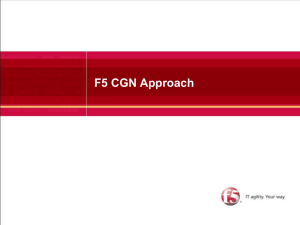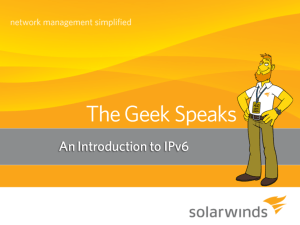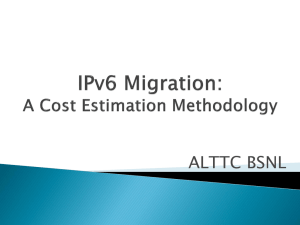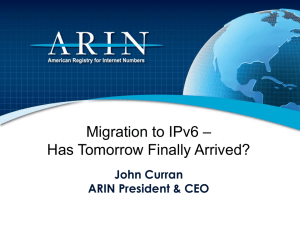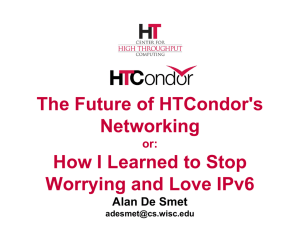Slides
advertisement
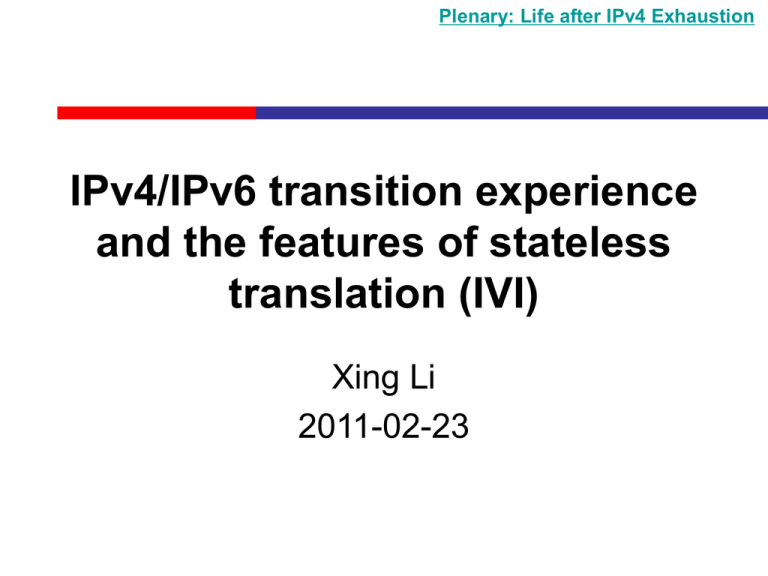
Plenary: Life after IPv4 Exhaustion
IPv4/IPv6 transition experience
and the features of stateless
translation (IVI)
Xing Li
2011-02-23
AS-level (1)
2
AS-level (2)
IPv4 AS count (35k)
IPv6 AS count (3k)
3
After IPv4 exhaustion
• In 172 days
– Increase AS number from 3K 35K
– Make 99% of the content IPv6 available
– Mission impossible
4
Ready and not ready
Contents: Not ready
Contents
Applications: Some is ready
Applications
NMS/Billing/CRM: Not ready
Core Network
Core: Ready
DNS: Ready
Metro Core
DNS
MultiService Edge Node
(BRAS/SR/GGSN/PDSN)
NMS
Billing
CRM
Access: Not ready
Mobile Access
Fix Access
xDSL FTTx LAN Wifi 1X、EVDO
Hosts: Most can be ready
Hosts
Mobile Devices: Not ready
Mobile Devices
5
IPv6 S curve
172 days
6
Who will be mostly affected
• The existing IPv4-only users
– They are happy now, until there are IPv6-only
content/users
– Upgrade to dual stack is not very urgent
– Upgrade to dual stack should not degrade
their experience
• The new users
– They do NOT accept the service if they
cannot access the global IPv4 Internet.
7
SP should make a decision in 172 days
(IPv4+NAT44)
NAT444
(IPv4+NAT44)
+
IPv6
Dual-tack Lite
IPv6
+
translation-to-IPv4
IVI, NAT64
8
IPv4/IPv6 transition standard roadmap
Solution
Standard /Draft
Standard
roadmap
note
IVI (stateless)
RFC6052* (addr-fmt), RFC6144*
(framework), RFC6145* (xlate),
RFC6147 (dns),
ivi*, [in IETF-editor queue]
Est. Mar,
2011
IETF
behave
WG
NAT64 (stateful) RFC6052* (addr-fmt), RFC6144*
(framework), RFC6145* (xlate),
RFC6146 (stateful), RFC6147 (dns)
Est. Mar,
2011
IETF
behave
WG
Dual Stack lite
Dual-stack-lit-06 [AD
Evaluation::Revised ID Needed]
Est. Q2,
2011
IETF
softwire
WG
6RD
RFC5969
Aug, 2010
IETF
softwire
WG
NAT444
nat444-03
Est.
Unknown
Not in
IETF WG
* CERNET authors/co-authors
9
If IPv6 is so great, how come it is not there yet?
• Applications
– Need upfront investment,
stacks, etc.
– Similar to Y2K, 32 bit vs.
“clean address type”
• Network
– Need to ramp-up
investment
– No “push-button”
transition
• IPv4 exhaustion does not change this
– NAT44 vs. IPv6
10
CERNET and CERNER2
IPv4
2,000 Universities
25,M Users
IPv6-only
200 Universities
2M Users
11
To encourage transition
• CERNET (IPv4)
– Congested and charged.
• CERNET2 (IPv6)
– Light loaded and free of charge.
• So, for using high quality and free network, port
your application to IPv6.
12
IPv4 and IPv6 traffic
IPv4
•
IPv6
CERNET IPv6’ traffic is about 20% of IPv4
13
So what are IPv6 traffics
• Mostly video
• Anything which cannot be accessed via
IPv4
• If both IPv4/IPv6 are available, the users
prefer to use IPv4 (better experience)
• Except EE and CS students
14
When will be the X’-day?
• We have asked our customers
– Can we turn off CERNET (IPv4) and only
provide CERNET2 (IPv6) services?
– The answer is absolutely NO! If there is a
single IPv4-only content in the global Internet,
we can not turn off IPv4.
• We have almost reached X-day (IPv4
address depletion)
• When will be the X’-day (turn off IPv4)?
15
The killer application
•
•
•
•
Video?
P2P?
Internet of Things?
The
intercommunication
with the IPv4 Internet
is the killer application
of IPv6.
16
We invented IVI
Global
IPv4
Global
IPv6
IPv4accessible
servers/clients
CERNET (IPv4)
CERNET2 (IPv6)
17
Translation scenarios
The IPv4
Internet
IVI {
DNS
An IPv6
Network
Scenario 1 “an IPv6 network to the IPv4 Internet” < NAT64
Scenario 2 “the IPv4 Internet to an IPv6 network”
An IPv4
Network
IVI {
xlate
xlate
DNS
An IPv6
Network
Scenario 5 “an IPv6 network to an IPv4network” < NAT64
Scenario 6 “an IPv4 network to an IPv6 network”
An IPv4
Network
xlate
DNS
The IPv6
Internet
Scenario 3 “an IPv4 network to the IPv6 Internet” < NAT64
Scenario 4 “the IPv6 Internet to an IPv4 network”
The IPv4
Internet
xlate
DNS
The IPv6
Internet
Scenario 7 “the IPv6 Internet to the IPv4 Internet”
Scenario 8 “the IPv4 Internet to the IPv6Internet”
18
Stateless translation (IVI)
IPv6
IPv4
IVI
A subset of IPv6
addresses
Real IPv4 host
mirrored IPv6 host
mirrored IPv4 host
Real IPv6 host
A subset of IPv6 addresses
19
www.ivi2.org
20
1:N IVI
IPv6 address
port
IPv4 address
i=0
i=1
84
85
202.38.108.5
86
port
2001:db8:a4a6:3ac8:c00a:2000::
84
2001:db8:a4a6:3ac8:c00a:2001::
85
2001:db8:a4a6:3ac8:c00a:2002::
86
2001:db8:a4a6:3ac8:c00a:2003::
87
i=2
87
i=3
• If R=256
• A /24 is equivalent to a /16
21
1:N dIVI
Hgw0
The IPv4
Internet
The IPv6
Internet
1:N
IVI
An IPv6
network
H0
DS
Hgw1
H1
DS
Hgw2
H2
DS
HgwK
HK
DS
22
Make things easy and simple
• Service Continuity
– Only upgrade core network to dual stack
– Keep the existing IPv4 access network running as
usual
• Minimal customer Impact
– Deploy IPv6-only data center with 1:1 IVI to move
content to IPv6 without loosing the IPv4 users
– Deploying new IPv6-only access network with 1:N
double IVI for new customers using shared IPv4
addresses
• Incremental investment
– Incremental deployment with direct returns.
23
Remarks (1)
• Dual stack and tunnel are coexistence
technologies
– 10 year experience indicates that we have not
achieved transition via dual stack and tunnel
• Let’s try translation now
– We need a single Internet, not two Internets
(IPv4 and IPv6)
– Due to the long tail, the transition cannot be
achieved in short time
24
Remarks (2)
• The competition is what type of translation
technologies we will use
IPv4 Internet
NAT44
RFC1918
NAT44
RFC1918
IPv6
IPv6
IPv4 Internet
NAT44
RFC1918
IVI
IPv6
IPv6
IVI
IPv6
IPv6
IPv6 Internet
•
IVI
Translation between
– IPv4 and RFC1918
IPv6 Internet
•
Translation between
25
– IPv4 and IPv6
Conclusions
• IPv6 is the right direction and it works
– A lot of addresses
– End-to-end address transparency
• IPv6 is not easy – the rest of users and contents
may still use IPv4
– Service Continuity
– Minimal customer Impact
– Incremental investment
• The universal connectivity is the fundamental
requirement for using Internet
– Translation
26
IVI IPv4/IPv6 transition
IPv4
Transition
IPv4 area
IPv6
IPv6 area
Service
Support
IPv4
Support
IPv6 (IVI)
V4 only Network
Support
IPv6 (non-IVI)
V6 only Network
Network
IVI
User
Support IPv4
Support IPv6 (IVI)
Support IPv6 (non-IVI)
27

